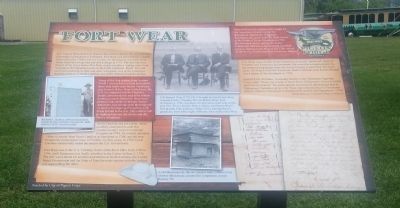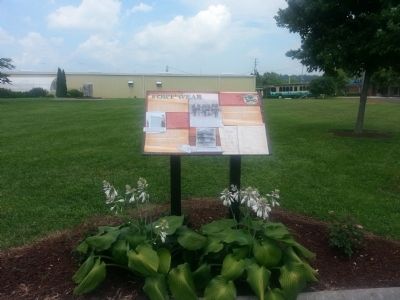Pigeon Forge in Sevier County, Tennessee — The American South (East South Central)
Fort Wear
Some of the first settlers from western North Carolina had received land grants from their home state before Tennessee was formed. When Wear settled here, the U.S. Government and the Cherokee people considered this area to be Indian hunting grounds. However, there were pioneers who believed that the Native Americans had relinquished their right of ownership by aligning themselves with Great Britain in the war. This conflict led to fighting between the whites and the Native Americans.
North Carolina, not yet a state, unsuccessfully attempted to cede this western country to the Continental Congress in 1784. As a result, pioneers chose to secede from North Carolina at Jonesboro in 1784, and the area became the independent State of Franklin for four years. In 1789, North Carolina successfully ceded the area to the U.S. Government.
Fort Wear was in the U.S. Territory South of the River Ohio from 1790 to 1796, until Tennessee was finally admitted to the Union on June 1, 1796. The fort was a haven for soldiers and settlers as North Carolina, the United States Government and the State of Franklin made treaties with the Indians, one superseding the other.
Samuel Wear was a patriot who fought for the American Colonies before the Revolution. During the American Revolution, he stood with Col. John Sevier at the Battle of Kings Mountain in1780. He defended settlers during the Indian Campaigns and was commissioned a colonel prior to fighting in the War of 1812. He served in the Sevier County and East Tennessee Militias.
Col. Wear was a leader in the formation of county, territorial, State of Franklin and Tennessee governments. He served as representative to the territorial legislature and was Sevier County Court Clerk for many years. He helped draft the Tennessee State Constitution in Knoxville and was a signer of the document in 1796.
Samuel Cole Williams, Associate Justice of the Tennessee Supreme Court, said: “Wear was a man of much force of character, brave in battle and wise in council.” His participation in territorial government and in Tennessee’s formation gives Col. Wear a prominent place in Tennessee history. (Below) Tennessee Constitution Preamble and Signatures – 1796 Photos below by Tennessee Library & Archives
(captions)
Richard L. Kelton, a Wear descendent, stands by the Colonel’s monument, dedicated in 1925, located nearby. Col. Samuel Wear (1753-1817) brought his family here from Augusta County, Virginia. His son Robert Wear, born November 4, 1781, was likely the first white child born in this area. Col. Wear’s brother John, a soldier, marched to Wear’s Fort in early 1782. (Above:) Three of Col. Samuel Wear’s grandsons, from left to right: Jefferson, John and Lavater Wear.
(Left) Illustration by Phyllis Hatcher Sims. (Above) Fort Marr Blockhouse, pictured for comparison, is near Benton, TN.
Erected 2013 by City of Pigeon Forge.
Topics. This historical marker is listed in these topic lists: Forts and Castles • Native Americans • Settlements & Settlers • War, US Revolutionary. A significant historical month for this entry is June 1890.
Location. 35° 48.405′ N, 83° 35.006′ W. Marker is in Pigeon Forge, Tennessee, in Sevier County. Marker is on Library Drive, 0.2 miles north of Community Center Drive, on the right when traveling west. Located in Pigeon Forge City Park east of the tennis courts parking lot behind the public library. Touch for map. Marker is at or near this postal address: 2449 Library Drive, Pigeon Forge TN 37863, United States of America. Touch for directions.
Other nearby markers. At least 8 other markers are within 2 miles of this marker, measured as the crow flies. Wear's Fort (approx. 0.3 miles away); Henderson Springs Resort (approx. 0.4 miles away); Shiloh Church (approx. 0.6 miles away); a different marker also named Shiloh Church (approx. 0.6 miles away); Pine Grove Rural Community (approx. 0.7 miles away); Titanic Eternal Flame (approx. one mile away); Titanic’s Center Anchor (approx. one mile away); Early Pigeon Forge (approx. 2 miles away). Touch for a list and map of all markers in Pigeon Forge.
Credits. This page was last revised on June 16, 2016. It was originally submitted on June 13, 2013, by Marcia Nelson of Pigeon Forge, Tennessee. This page has been viewed 1,553 times since then and 70 times this year. Photos: 1, 2. submitted on June 13, 2013, by Marcia Nelson of Pigeon Forge, Tennessee. • Bernard Fisher was the editor who published this page.

